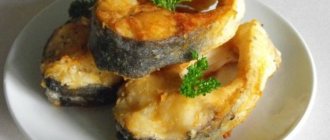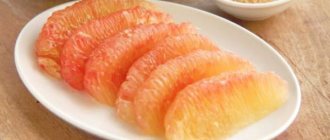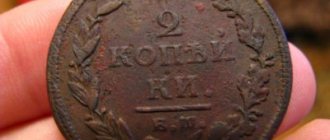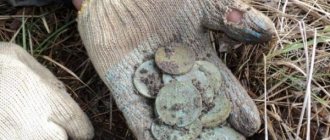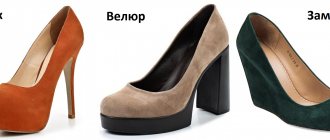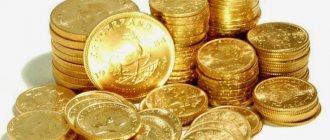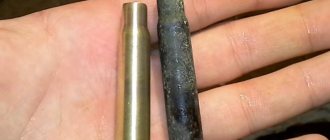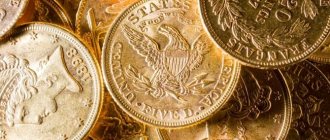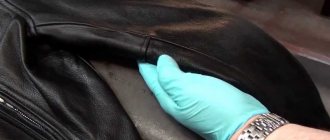Today we will talk about how to clean old coins. Every year they gain even more value, but the price greatly depends on the condition. Therefore, an item preserved in proper condition receives additional value. When antique coins are kept in unfavorable conditions, dirt, oxides and deposits of different colors develop. You can use special solutions that are sold in jewelry stores, but not everyone can afford it. Therefore, let's look at how to clean an ancient coin using available methods.
General information about cleaning coins
It is important to understand that not all specimens require serious cleaning; sometimes the procedure can even be harmful. It would also be good to learn to distinguish patina from oxide and plaque, since it gives the metal nobility and protects it from external factors. Every collector knows that a layer of patina is more important than a brilliant shine.
If this is your first time trying to clean old coins at home, it's best to start with the least valuable coins. If they fail, they will not be so sorry. On them, try the method that interests you. When it comes time to work at elevated temperatures, try to ensure that the transition from room temperature to high is smooth. A sudden change can damage the metal.
When you have to use a brush, it is better to use a soft one, such as a toothbrush. Do not use items with metal bristles or sandpaper.
It is important to dry properly, especially antique coins. To do this, you need to place them on a soft cloth and carefully apply it on top several times. It happens that drops of water leave their mark on antiques.
See also video: 3 ways to clean old coins at home
How to clean 10 ruble commemorative coins
- Bimetallic 10 ruble coins will look like new if you clean them with whitening toothpaste and a brush. Then rinse the specimens thoroughly.
- Yellow plaque can be removed with vinegar. You will need a glass of 9% acetic acid solution, into which you need to put 10 rubles. After an hour, remove the specimens and rinse with hot water. If the stains are not completely removed, brush with toothpaste.
You should not clean anniversary pieces using sandpaper, a stiff brush or scrapers. There is a risk of completely ruining the money.
Starting the cleaning process
We choose a cleaning method depending on what type of dirt we are dealing with. There are chemical and mechanical, in the second option we are talking about dirt, dust, earth and other contaminants that are cleaned mechanically without the use of special means. The first method involves a certain chemical reaction that will help wash the coin from oxide, green plaque or any other.
If you have not previously worked with the methods below, carefully follow the instructions and do not overdo it so as not to damage the product. Moreover, you should not change the recipe or come up with your own.
Cleaning from contaminants
At this stage we are talking about mechanical cleaning. Depending on what kind of metal we are dealing with and how dirty it is, we choose the cleaning method:
- A soap solution can handle minor stains; use it to remove dirt using a brush or an old toothbrush.
- In difficult cases, we act depending on the composition of the coin. You can use the methods given in the paragraphs below.
- If the pattern on the surface is not visible, put it in a soap solution for 10-15 minutes. You can use laundry soap. After this, using a toothbrush, carefully wash the coin directly in the water. Then we dry it.
How to clean a coin found in the ground
Often, when searching for old coins, they are found in the ground; such finds often resemble those from the USSR. Sometimes they lie there for years and the dirt has become so ingrained that it has become almost integral to the product. Cleaning such coins at home will be done by boiling.
You need to make a soda solution, one tablespoon of soda per glass. It is better to place the contaminated item in a sieve or something similar so that it does not lie at the bottom of the pan. Bring the water to a boil and leave to simmer for half an hour. Now turn off the heat source and let the water cool slightly. We take out the product and carefully clean it using a toothbrush or other soft brush. We carry out the procedure as many times as possible until the coin restores its normal appearance.
Cleaning with baking soda
In this case, we will clean coins from oxidation using ordinary soda, which will be used as an alkali. That is, the main task is not mechanical cleaning, but chemical cleaning. We make a regular soda solution and immerse the products there. The concentration of the solution depends on the complexity of the case; as a rule, add 1-2 tablespoons of soda to a glass of water. After a few hours, pull it out; if there is still plaque, remove it with a soft cloth and dry it.
You can make a kind of paste from soda and water. We put coins there for a certain time and periodically watch it so that the soda does not start to dry out right on the surface. After the procedure, remove and use a soft brush to clean all residues from plaque and oxide while simultaneously rinsing in water.
You can make your own cleaning products. To do this, we make a mixture of ammonia, soda and toothpaste. By closing it all in a jar it can be stored for a long time. Cleaning with its help is very simple, apply the mixture and wash with a toothbrush.
Cleaning a coin with soap
The basic method for cleaning an old coin involves using a soapy solution. We rub the soap shavings on a grater and soak them in boiling water so that a mixture somewhat reminiscent of jelly is formed. Place a coin there, cover and leave for 1-2 days. In difficult cases, add soda, 2-5% of the total mass of the solution. When time has passed, remove it. Rinse under running water and dry. Soak in alcohol and leave until completely dry.
Boiling down coins
Vaseline or vegetable oil is heated and a coin is immersed in a strainer for 10 minutes. Wash with running water and soap. Pour clean water into a vessel, immerse our coin in it, heat it to a boil and leave to cool. After the procedure, wipe the product dry.
Jewelry Cleaners
The best option for cleaning an old coin at home is a jewelry cleaner. It can be purchased at jewelry stores and workshops. This could be a napkin or solution. In the first case, you need to wipe the surface of the product. In the second, immerse the coin there for 5 minutes.
It is better to entrust valuable coins to professionals. It would be a shame to ruin an antique due to your own incompetence. The workshop will not only clean it, but also polish it and may apply an additional layer of protection.
What is brass and where is it used?
Brass is an alloy of copper and zinc. The material contains elements such as manganese, tin, aluminum and lead particles, which change the characteristics and color shades of the metal. Zinc was discovered in the 16th century, but brass was discovered in ancient times. The metal was obtained by melting copper and zinc-containing ore.
When making the alloy, up to 30% zinc is added to the composition, but to improve technical characteristics, up to 50% metal is added. Brass practically does not wear out and is used in the manufacture of automotive spare parts, serpentine elements, heating radiators, as well as stamped parts and various accessories. Alloy brass is used for the production of aircraft, ships, watch parts and main pipes.
Using tombak (an alloy with a zinc content of no more than 10%) insignia is made. To protect elements from corrosion, cast brass is used. It is used to manufacture bearings, shut-off valves, and separators. Thanks to the properties of the alloy, compasses and heating radiators are produced. Cleaning of brass is carried out without the use of additional equipment and special products.
The metal is used in jewelry in the manufacture of costume jewelry, as well as counterfeit gold jewelry. The alloy content of up to 15% zinc and the addition of 5% aluminum allows you to obtain a material similar to precious. This condition is used when making frames for icons, as well as other items in churches.
Cleaning depending on alloy
The most common coins are:
- Golden,
- Silver,
- Bronze,
- Copper.
Depending on the metal, the cleaning method is determined. More details about each can be found in the relevant articles on our website.
Pure gold
Coins made of gold are surprisingly easy to clean. To do this, you can use one of the methods below:
- Make soapy water in a glass and add 10 drops of ammonia. Place the product there for 10-15 minutes. Wipe dry.
- To restore the shine to gold, onion juice is a cheap and effective remedy. Using a soft cloth, rub the surface of the metal with it and leave for several hours. Rinse under running water and wipe dry.
- In stores you can buy a special paste for laundering gold.
Laundering silver
Silver coins are durable, so they are much more difficult to damage. It is not recommended to use baking soda with this metal. At first it will cope with its task, but over time micro-scratches may form. So how to clean silver?
- The easiest way is with toothpaste (or powder) and a brush. Apply the product to the surface and scrub until it returns to its normal appearance.
- Make a solution of citric acid in a ratio of 1:3. We put our coin collection there and leave it for 10 minutes. Take it out and clean it with a toothbrush.
- Sometimes, to restore shine, simply immersing it in ammonia for 2 minutes is enough.
Cleaning bronze
If there is no damage, oxide or any deposits on the surface, then it is treated mechanically using a soap solution. In other cases, we resort to one of the methods below.
- As in the case of silver, we make a solution of citric acid, but this time you will need a 1:2 ratio. Place the product there for 10 minutes, rinse and wipe dry. The color may change slightly, but after a few days everything will return to normal.
- An excellent method for cleaning antique gold coins is to use vegetable oil. With its help you can not only restore the appearance, but also add an additional protective layer. To do this, you need to bring the oil to a boil and gently lower the coin there for 5 minutes. Remove and immerse in ethyl alcohol for the same amount of time. Rinse and dry.
Processing copper coins
On copper coins, not only oxide is possible, but also yellow, white, red and green patina.
- If the coin is covered with a red layer, a solution of ammonium carbonate or 5% ammonia will help. Immerse the item in the solution for 5-10 minutes, wipe well and dry.
- The above-mentioned citric acid in a ratio of 1:10 will help with green.
- Regular table vinegar will help remove yellow stains. Dip a coin into it for 5-10 minutes, wipe and wipe dry.
- The easiest way to wash off the white coating is to simply take distilled water and immerse dirty copper coins in it for several days. Remove and wipe with a soft cloth.
- In particularly problematic cases, use Trilon-B.
Another way to clean copper coins in the video:
General information
Year of issue and material from which Soviet coins are made
In 1991, new coins began to be issued in denominations of 10, 5 and 1 ruble, as well as 50 and 10 kopecks. The difference was that they were made from other metals. Let's try to understand this in more detail.
Coins from 1961
To make some coins (1, 2, 3, 5 kopecks), metal from a copper-zinc alloy was used. For the rest (10, 50 kopecks, 1 ruble, nickel was used.
Coins from 1991
Money in denominations of 10, 50 kopecks, 1, 5, 10 rubles were made from alloys (steel and brass, copper-nickel alloy). Rubles were made from compounds of copper-nickel and copper-zinc alloys.
What not to clean
Before you clean an antique coin, there are a few things to keep in mind. The following formulations are contraindicated for this product.
- Highly concentrated solutions of sulfuric, nitric, hydrochloric and acetic acid. They can melt the coinage.
- Chlorinated tap water. Chlorine settles in small parts.
- Heating to maximum heat: it leads to the destruction of the metal.
- Brushes with metal bristles: they are stiffer than brass or with natural and artificial hair. Distort the surface relief.
- Sandpaper: it removes the patina from copper and bronze and changes the embossed relief.
Home Remedies
First of all, arm yourself with the right tools. You will need a medium-hard brush and a soft cloth. The cleaning procedure is carried out using several methods.
Method 1. Wipe the coins with a weakly concentrated solution of hydrochloric acid. Dry the products. Please note: this composition is quite aggressive. It is not used for cleaning antique coins.
Method 2. Treat coins with a 3-5% vinegar solution. Apply a small amount of toothpaste to the surface. Rub gently. Wipe up any remaining residue with a damp cloth. Sand until shiny with dry flannel.
Method 3. Pour Coca-Cola into the container. Place coins in your drink overnight. In the morning, rinse the items under running water. Polish with a soft cloth.
Method 4: Place coins in soapy water. Clean the surface with baking soda without removing it from the water. Treat with a cotton pad soaked in ammonia. Rub with baking soda again. Rinse and polish the product. Baking soda is an abrasive substance, so it will not clean old coins to a shine. There may be minor scratches on the metal.
Method 5. This is the most gentle cleaning option. To work you will need laundry or baby soap. Grind ⅛ part of the bar. Dissolve soap shavings in 1 liter of water. To speed up the process, heat the liquid. Soak the coins in the prepared mixture. Leave them for 3 to 10 hours, depending on the degree of contamination. Then scrub with an old toothbrush. Once the coins start to shine, rinse under running water and polish with a dry cloth.
Year of manufacture and material of manufacture
In 1991, the time came to issue new money in denominations of 10, 50 kopecks and 1, 5 and 10 rubles, but from other metals. Let's deal with this now.
1961 coin issue:
- for the production of coins from 1 to 5 kopecks, copper-zinc alloy metal was chosen;
- coins in denominations from 10 to 50 kopecks. and 1 ruble - from nickel.
Money issued in 1991:
- in denominations of 10, 50 kopecks and 1, 5 and 10 rubles were made of alloys (10 kopeck coin - steel treated with brass; 50 kopeck coin - copper-nickel alloy);
- 1, 5 and 10 rubles are made of a compound of two metals (the central part is made of a copper-zinc alloy; the outer ring is made of a copper-nickel alloy).

